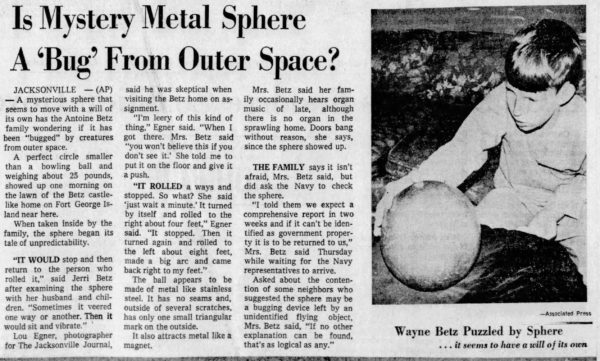
What is the Betz Mystery Sphere? Is it alien technology left behind by extraterrestrial visitors? Or is it something manmade, and the real mystery is how it ended up on one Florida family’s property to begin with?
No matter what it is, the headline-making and conspiracy theory-generating ball is part of American history and lore. Part of which is being threatened.
The family’s home where the ball was taken after it was found has been abandoned, neglected, and is on the verge of destruction. Can one passionate paranormal investigator and writer save it? Let’s unpack this dilemma, starting with how the story all began.
The Betz Mystery Sphere
In 1974, Gerri and Antoine Betz were walking in the woods with their oldest son Terry (21) on their property on Fort George Island in Jacksonville, Florida. They found a shiny, heavy sphere that looked similar to a bowling ball. However, in addition to not having any finger holes, the eight-inch diameter, 22-pound sphere also weighed more than the heaviest bowling ball, which weigh between 6 and 16 pounds.
Was it an old canon ball? It didn’t look like one and was in far too good of shape. Still, it was unique, so Terry took it home.
They had it for two weeks before they said weird things started happening. For instance, when Terry played guitar, the ball “hummed” back. The Betzes also reported that the ball rolled around on its own and emitted a high-pitched noise that they didn’t hear, but that would make their dog whine and cover its ears.
They heard something too, though. Mysterious organ music —even though there was no organ in their home. They also claimed that doors suddenly started slamming shut on their own too.
As Skeptoid reported, they contacted the newspaper, hoping someone would know what it was and give them some answers. The Jacksonville Journal sent out Lou Egner, a photographer. He verified witnessing the ball move on it own.
Shortly after the story ran locally, it was picked up nationally and even internationally. Or, as we say these days, it went viral.
Determining the Betz Mystery Sphere’s Origins
But what was the ball? Was it something manmade, or did it have extraterrestrial origins, as the Betz family (and many others) believed?
Carl Willson’s Examination
One of the people who took an interest in the story of the mysterious sphere was Carl Willson from Omega One, a holistic institute in Baton Rouge, Louisiana. He traveled to the Betz’s house in Florida to exmaine the ball and determined not only that a magnetic field surrounded it, but also that it was transmitting a radio signal.
The Navy’s Examination
The U.S. Navy wanted to take a look at it to determine if it was something of theirs. Had it come from Naval Station Mayport, which is right near Fort George Island? Gerri Betz, who became the family and the ball’s spokesperson, gave them two weeks to study it. But she also made them sign a contract that they’d return it if they determined it wasn’t government property.
The Navy determined it wasn’t government issued, but they didn’t know what it was either. Or, rather, what it might have been used for. X-rays revealed three or four smaller spheres inside, but it wasn’t radioactive or explosive, nor did they detect any sort of magnetic field or radio signal like Carl Willson claimed.
Metallurgist Fred Thomas, who examined the ball for the Navy, determined it was made of high-grade stainless steel. The Navy said it was impossible to determine anything more without cutting it up, but Gerri refused to let them do that.
Another thing they noted was that it never rolled around on its own while they studied it. But why did it happen at the Betz’s house then?
The Navy theorized “its tendency to move around was due to a small triangular chip in the surface that threw off its otherwise perfect balance,” and that it was likely uneven floors in the Betz’s old home that sent it rolling.
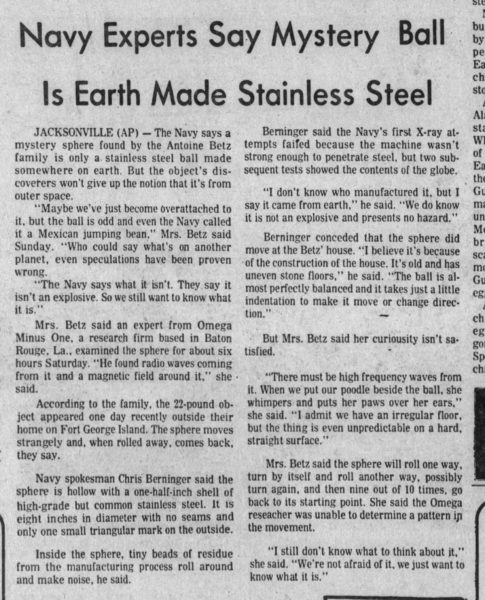
The National Enquirer’s UFO Panel
Next, the National Enquirer got involved. They took the “Odd Ball” to an already planned conference in New Orleans to have their Bue Ribbon Panel of UFO Investigators examine it. At that time, the Enquirer was offering $50,000 for proof of ETs or UFOs.
And even though the National Enquirer wasn’t taken seriously even back then, the members of their panel were. Each was a scientist or engineer. Among them was J. Allen Hynek, an astronomy professor at Northwestern University and a member of the Astro Phenomena Research Organization (APRO). Thanks to his book, The UFO Experience: A Scientific Inquiry, he was also probably the best-known ufologist at that time.
Dr. Hynek agreed that the ball was stainless steel 431 and likely of terrestrial origin. However, he acknowledged it was possible extraterrestrials could also produce such a material. Who knows?
Like the Navy, he also noted it never moved on its own while he was studying it. The only other thing he and his panel deduced was that it rattled slightly when shaken
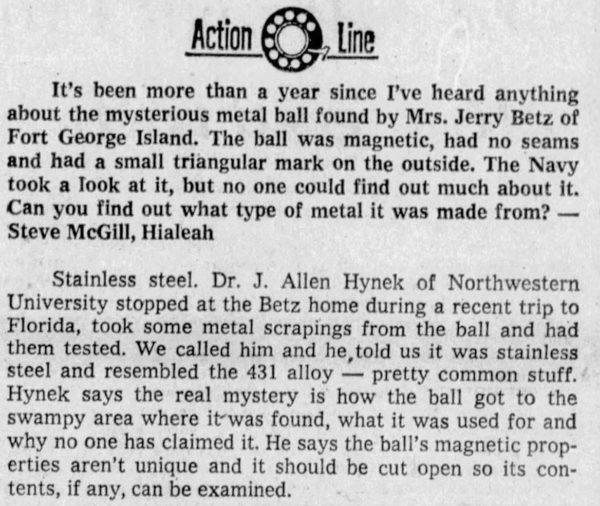
The Ball, Explained
There were a few plausible guesses —beyond it being something of UFO origins— to explain what the mystery sphere likely was.
For instance, an Apr. 16, 1974 article in The Tampa Times reported that a caller to United Press International (UPI) identified himself as an employee of Bell System Laboratories. He admitted he hadn’t seen the ball in person but that from its description, it sounded like a tide and current transcriber of the type used in oceanographic research.
Skeptoid reported that “technicians from the St. Regis Company paper mill identified it as a ball check valve from some large pipes used in their factory.” When papers ran that, Robert Edwards, a then-president of a Jacksonville supply company, contacted a UPI reporter to show him a brand new similar stainless steel ball they had in stock. It was manufactured by Bell & Howell in Bridgeport, Connecticut, and weighed and measured the same as the Betz mystery sphere.
But did the ball actually come to Fort George Island by way of artist James Durling-Jones? He’d created sculptures using similar balls and had even passed through Jacksonville in 1971 collecting scrap metal. A friend of his there had given Durling-Jones large industrial ball check valves from the company he worked at, some the exact size and weight of the Betz Mystery Sphere. When he ran out of room to store them in his VW van, he put them in the luggage rack on the roof, where a few ended up rolling off.
That’s the explanation most people believe solves the mystery of how the ball came to be on the Betz’s property.
Of course, all of this seemed too mundane not only for the Betz family but for those who believed the sphere was extraterrestrial in nature. There was a way to definitively get to the bottom of it (cut it up), but Gerri Betz refused. (Which tells me she really didn’t want to know what it was that bad after all.)
What happened to the Betz family and its ball?
The one thing Gerri Betz didn’t appreciate was how much interest the ball would generate. The family had lived a quiet life on their 20-acre property until that point. Now the phone rang off the hook 24/7 with people wanting to see the ball and offering theories —and warnings— about it.
There was only one thing to do. The Betz family packed up their ball and retreated from the spotlight.
As for the ball…I don’t know if one of the family members still has the actual one. When I visited the Museum of the Weird, they had a Betz Mystery Sphere on display. Was it a replica or had they somehow gotten their hands on the real thing?
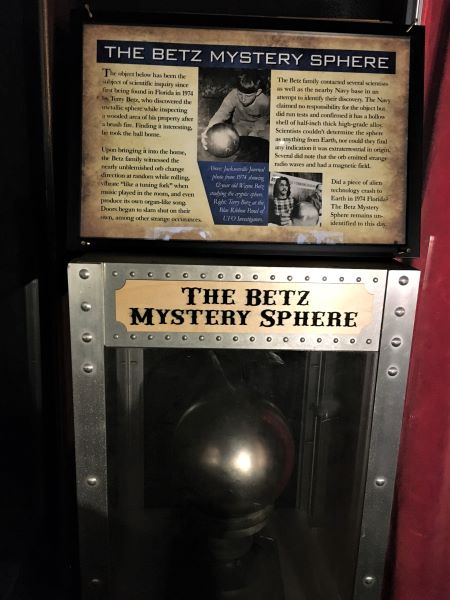
I don’t know, but the home where they brought the sphere and where its story transpired has a history of its own.
The Neff House/Betz Castle
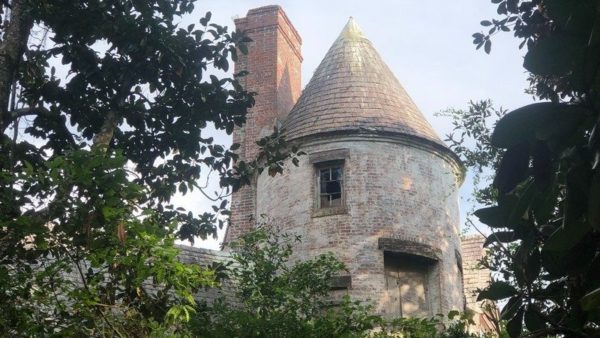
Jacksonville architect Mellen C. Greeley built the Tudor-Revival style home with the circular entry tower where the Betz family lived in 1927 for Nettleton Neff, a Chicago businessman. Sadly, Neff’s wife and three children died six months after construction started. Neff ended up committing suicide and never saw his “castle-like” home completed.
It sat empty until years later when Kenneth Merrill bought it as a holiday retreat for his family. He owned Merrill Stevens Ship Building Co., the St. Johns River Shipbuilding Co., and the Merrill Dynamite Co. They owned it until they sold it to the Betz’s in 1967.
As the Jacksonville Historical Society explained, the Betz family was the first to live in it as a full-time home. They added a kitchen wing, as well as a garage and swimming pool to the 21-room mansion.
The Betz’s sold the home to Fairfield Communities in 1985. They used it as housing during archaeological projects until the Florida Park Service bought the property in 1989, which they used as office space and a ranger residence.
In 2002, serious structural problems forced them to remove the wing that the Betzes had added. And then that was sort of the end of the house being used at all. It was sealed up, never to be used again after that. It’s now part of Fort George Island Cultural State Park and is marked with “no trespassing” signs.
The Plea for Preservation and the Petition
Normally I don’t condone trespassing. Not only is it disrespectful, but it’s dangerous. However, every once in a while, it can lead to good things. In fact, I owe the resurrection of one of my favorite destinations, the Jekyll Island Club, to trespassing urbexers.
Paranormal investigator and author Chaz C.M.P.’s latest book, A Place Between Time and Space: A true story of Ghosts, UFOs, and Florida’s Strangest Home, details the full story of the Betz house, as well as his investigations of the property. Which, he concedes, were done illegally and without permission, after he tried to obtain permission, but his requests were denied.
He argues the house is a window to Florida history. The house is situated on Mt. Cornelia, which isn’t a mountain but is the highest point in Duval county. Five thousand years ago, Timucua tribesman lived on the land. The first Protestant prayer in the new land was prayed there when John Ribault landed on the island in 1550. The British built Fort George there 200 years after that.
The house is but a small part of the history, but one Chaz argues should be preserved instead of being left to “rot in the wet heat of Florida,” as has been the case. He’d like to see it receive the same care and protection as two other nearby Fort George Island gems, the Kingsley Plantation and the Ribault Club.
He’s so passionate about it that he’s created a petition he’d like to submit to the U.S. National Park Services to save the Betz/Neff Historical House. He’s imploring fellow paranormal enthusiasts and historians, whether they be Florida residents or not, to sign.
Visit this link to add your name: https://www.change.org/p/save-the-betz-neff-historical-house?recruiter=1271729089.
Check-In
Do you think current technology could ascertain what the Betz Mystery Sphere is without drilling into or destroying it? Or do you think if it can’t and if the real ball is ever located again, that it should be properly studied to set the rumors and conspiracy theories to rest once and for all?
Courtney Mroch is a globe-trotting restless spirit who’s both possessed by wanderlust and the spirit of adventure, and obsessed with true crime, horror, the paranormal, and weird days. Perhaps it has something to do with her genes? She is related to occult royalty, after all. Marie Laveau, the famous Voodoo practitioner of New Orleans, is one of her ancestors. (Yes, really! As explained here.) That could also explain her infatuation with skeletons.
Speaking of mystical, to learn how Courtney channeled her battle with cancer to conjure up this site, check out HJ’s Origin Story.

We know that it’s hollow or has a lightweight material on the inside, because it’d be heavier if it were solid. (At 8 inches it’d be about 75 pounds if it were solid 431 steel.) Xrays will penetrate stainless steel, but not very deep. So… yeah, I think it’s a mystery unless we cut it open.:-(
OH SNAP!!!! So in ALL of the research I did on the subject of the sphere NONE of the scientists brought up the weight based on the size and whether it was hollow or not!!! Or if they did, it wasn’t reported on. Not that I’ve read every book on the subject, but I LOVE that you’re engineering background kicked in!!!! THANKS for sharing this!